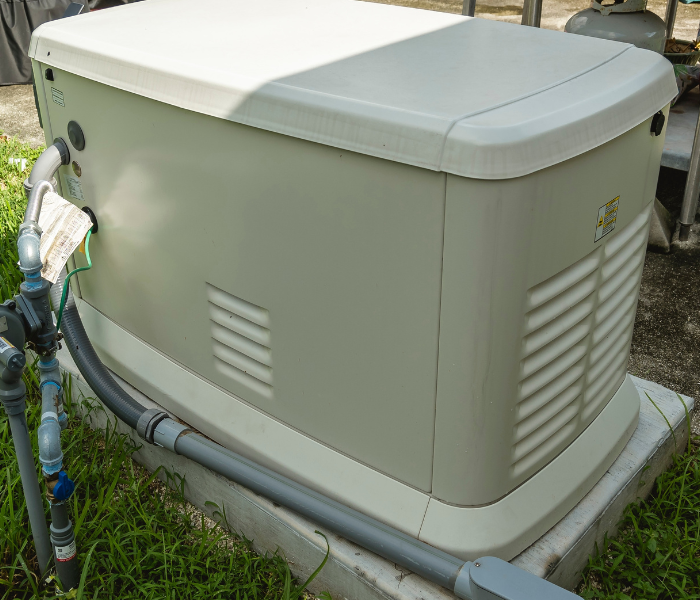The climate is changing and, with it, the weather has become more unpredictable. In certain areas, this has caused storms and other natural calamities to bring more frequent power outages. And, if you have been involved in more than one, you have probably started to think about investing in a generator.
Standby and portable generators are the most trusted backup power solutions, and they both do a great job at keeping your home functioning and safe during a power outage. However, there are some considerable differences between the two that are worth keeping in mind before committing to an investment!
Standby Generator: A Trustworthy Alternative
Standby generators are more costly than portable generators, and they require maintenance and installation, but they represent a reliable and substantial power source during an outage. While the upfront cost can be intimidating, they can last for longer than 15 years and can represent an important safety feature during a power outage.
There are several kinds of standby generators, including:
- Home standby
- Whole-home generator
- Commercial generators
Whole-home generators are the ideal option to supply a steady stream of power to residential buildings. These generators are permanently mounted outside of the house; they don’t require manual starting, and come into action as the power outage happens.
Generally, whole-home generators can produce between 22kW and 50kW, which is enough to power your home’s appliances and live a normal lifestyle during an outage. The main benefit of a standby generator is that any essential appliance or medical equipment in the house will keep running in any eventuality.
Thanks to the entire automated system, you don’t need to be at home during a power outage to safeguard your property, and your children or senior parents are safe and warm without having to lift a finger.
Features of a Standby Home Generator
- Installation – standby generators are permanently installed on the side of the home. They need to be installed and maintained (every two years) professionally, which can represent a recurring cost.
- Starting – They automatically start when the power goes out, keeping everyone in the family safe.
- User-friendliness – they don’t require manual operations, but they have to be maintained and repaired professionally.
- Fuel type – they run on natural gas or propane, which don’t require refilling and guarantee steady power.
- Power – they can easily power lights, fridges, water heaters, and electric stoves. Whole-home standby generators can guarantee AC/DC power throughout the house.
- Safety – They are mounted on the outside of the house, which can prevent fatal CO poisoning, fumes, or electrical shocks related to the power surges that can happen after an outage.
Portable Generator: An Emergency Solution
Portable generators are an attractive alternative for homeowners, especially because of their low cost and user-friendliness. In an emergency, a portable generator can be enough to power the essential appliances and fixtures in your home. And they are versatile enough to be used in different locations if needed. Because of these reasons, many homeowners opt for this affordable convenience.
However, portable generators also boast considerable downsides that are worth keeping in mind. One of the most evident is the fact that it needs to be hand-operated and closely monitored while in use.
Therefore, to keep the appliances in your home running during a power outage, you need to be at home to start the generator. Failing to do so can cause a range of damages, from failed basement sump pumps to excessive food waste.
Additionally, portable generators are usually gas-powered, and their tank will be able to hold an average of 3-6 gallons. While this might be enough in an emergency, you will need to refill it multiple times to keep the power running.
Because of their gas tanks, portable generators also pose the risk of carbon monoxide poisoning, which affects over 430 people every year only in the US. Therefore, they need to be stored at least 10ft away from the house and, ideally, outdoors where there is plenty of air movement.
Features of a Portable Generator
- Installation – no installation is needed, but they require safe storage.
- Starting – they require a manual starting by pull-cord. They have to be closely monitored when in use.
- User-friendliness – it is easy to operate and portable but might not be suitable for seniors or children at home alone during an outage.
- Fuel type – they generally use gas stored in 3-6 gallon tanks. For prolonged power outages, you will need to store extra tanks.
- Power – can only power the selected essential devices that are plugged into it.
- Safety – it can pose a risk of CO poisoning, so it needs to be stored outdoors and away from the house.
Find a Tailored Solution For Power Needs
Each home is different, and so every power solution should be. Standby generators are undoubtedly reliable and trustworthy allies to have during an outage because they are not affected by gas shortages or human error. However, at Generator Supercenter, we can help you find a tailored solution that fits your needs.





